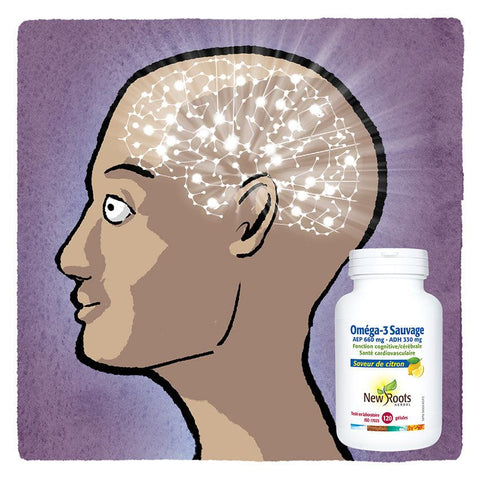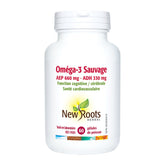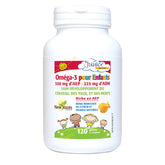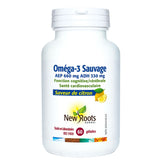Where there's good fat, there's omega-3! And contrary to popular belief, fats are nutrients of the utmost importance to human beings, and are not directly responsible for the excess weight we are witnessing today. The real culprits we don't point the finger at enough are sugar and alcohol..2, 3
The fats we eat penetrate our cell membranes and contribute to their protective function. On the other hand, it is imperative to ensure a high-quality, balanced intake. If we have good sources of fats, our body's 100,000 billion cells will be well protected, well nourished and our health will benefit..1, 2, 6
The example of the brain
Over 60% of our brain's dry weight is made up of fat. This same fat acts as an electrical insulator for neurons, and is involved in the activity of synapses, which in turn enable the transmission of nerve impulses..6
The role of healthy fats in our physiology
- Energetic : Each gram of fat provides 9 calories, making it the energy molecule par excellence.
- Creates reserves: This fat forms adipose tissue, the fat mass through which energy is stored. When carbohydrate intake is low, our body releases stored fat.
- Hormonal : There are a large number of specific hormones that are created by fat, because they are lipidic in nature (derived from cholesterol, e.g. estrogen).
- Insulating: Fat stored under the skin covers the organs, acting as a thermal insulator.
- Structural: Lipids such as cholesterol form part of all cell membranes.
- Transport: Some lipids play a transport role in the human body. For example, they help transport fat-soluble vitamins (vit. A, D, E, K) throughout the body..1, 2, 5
Choosing the right fats for your health
First of all, did you know that lipids, whether of animal or vegetable origin, provide different types of fats: saturated fats (solid at room temperature), monounsaturated fats (liquid at room temperature or opaque and solid if refrigerated) and polyunsaturated fats (liquid when refrigerated). To be healthy, we need all types of fat.1, 2, 5
Fatty acids protect every one of our cells
The cell membrane is essentially made up of fatty acid compounds: phospholipids. These phospholipids are large, energy-filled molecules that combine fatty acids and phosphorus, sometimes with an amino acid, sometimes with a vitamin.
Their properties of membrane fluidity, permeability and flexibility are strongly influenced by the nature of the phospholipids and their fatty acids. The longer and more unsaturated the fatty acid chain, the greater the fluidity and the greater the positive influence on cell metabolism..2, 6, 8
Omega-3 and omega-6
We often hear the bad reputation of omega-6. They are said to give rise to compounds that promote inflammation and blood clots, while omega-3s provide low-inflammatory, blood-thinning compounds. The reality is that both are essential and must be supplied by the diet..2, 5
A question of ratio
Ideally, there should be one omega-3 for every four to five omega-6s. However, a number of studies have shown that today, we consume ten or even thirty times more omega-6 than omega-3 in our diet. It's this major imbalance in omega-6s, and not their presence, that promotes inflammation, allergies, cancer, thrombosis, etc..2, 5
Sources of omega-6: derived from eggs, poultry, red meats, corn, almonds, sunflower seeds, walnuts and hemp seeds..1, 2
Omega-3s and their benefits
An essential fatty acid
These molecules are called "essential" because the body cannot manufacture them, so they must be obtained from the diet. If you can't find omega-3s in your diet, you can opt for a supplement..1, 2, 3, 4, 5, 6
Let's take a look at omega-3s. First of all, they are a type of unsaturated fatty acid.
There are three types of omega-3 polyunsaturated fatty acids: DHA (docosahexaenoic acid) and EPA (eicosapentaenoic acid), which come from animal (marine) sources and are found in oily fish such as salmon, tuna, herring, sardines and anchovies; and ALA (alpha-linolenic acid), which comes from plant sources and is found in flaxseed oil, hempseed oil and pumpkin seeds..1, 2, 6
- DHA-docosahexaenoic acid A major constituent of the retina and nervous system
- EPA eicosapentaenoic acid EPA: precursor of anti-inflammatory molecules (type 3 prostaglandins-PGE3)
- ALA Alpha-linolenic acid: ALA is also a precursor of the other two Omega-3s, EPA and DHA.1, 2, 6
Omega-3 functions
- Growth factors,
- Transport excess cholesterol
- Promotes healthy immune system function
- Help transport oxygen from the lungs to the cells
- Regulates blood clot formation and blood pressure
- Reduce muscle recovery time after exercise
- They are the precursors (simple organic molecules involved in the synthesis of large molecules) of prostaglandins, hormones which perform multiple tasks in our body, such as hormonal activity and various regulations
- Etc.1, 2, 6
Does your diet contain enough omega-3? 2-3 oily fish meals a week are recommended as a preventive measure against cardiovascular disease..1
Omega-3 metabolism
The main enzyme for conversion to ALA, EPA and DHA is delta-6 desaturase, which requires enzymatic cofactors to function properly..1, 2
Co-factors (substances required by an enzyme to catalyze a given reaction) for proper omega-3 metabolism include zinc, iron, magnesium, vitamin B3 and B6.
I therefore encourage you to take a multivitamin and mineral supplement for better omega-3 absorption..2
Factors inhibiting omega-3 absorption: consumption of trans-fatty acids (found in junk food), hyperinsulinemia, alcohol, viral infection, zinc deficiency, stress, etc..1, 2
Natural omega-3 supplements
Advice on how to choose them
- Always check the expiry date
- Fish oil in capsules is better protected from oxidation
- Liquid form should be consumed within 30 to 40 days of bottle opening.
- Taking omega-3 supplements with meals is easier to digest
- If you have fish deposits, freeze the capsules to minimize degradation in the stomach. The contents will then be released in the intestine.
- Opt for fish oil of the highest pharmaceutical quality, tested for heavy metals, contaminants and oxidation in an ISO 17025-certified laboratory..6, 7
New Roots Herbal Omega-3 supplements
For adults :
- Wild Omega-3 EPA/ADH in a ratio of 660 mg/ 330 mg pharmaceutical grade
- Lemon-flavored Omega-3 Sauvage AEP/ADH in a ratio of 660 mg/ 330 mg pharmaceutical grade
For children:
- Omega-3 for children 1680 mg including EPA/ADH in a ratio of 550 mg / 225 mg pharmaceutical grade
These omega-3s can be used to help maintain good overall health.
The benefits of New Roots Herbal Omega-3
Adding omega-3s to your diet, or as a supplement, plays an important role that can benefit you in the short, medium and long term.
These fatty acids are recognized for supporting good cardiovascular health, reducing and preventing mood and anxiety disorders, improving concentration and learning processes, reducing attention disorders, and improving certain aspects of immune response. Omega-3s help reduce inflammation and joint pain by reducing the production of inflammatory markers such as pro-inflammatory cytokines and stimulating the synthesis of anti-inflammatory mediators, etc..1, 2, 6
Omega-3, nourishing body, mind and family!
About the author
Marie Couture, Certified Naturopath
Specialized in :
- Digestive disorders
- Inflammation
- Hormonal problems
- Stress management
References :
Books :
- Frappier Renée, Gosselin Danielle, Le Guide Des Bons GrasLes Éditions Maxam, 1995, 1999, 403 pages
- Grégoire Serge Ph. D Les gras, Cholesterol and you From dogma to scienceEd. Berger, 2017, 260 pages.
- Joyeux Pr. Henri, Joyeux Jean, Eating better from 0 to 100 years oldéditions du Rocher, 2017, 326 pages
- Liesse Véronique, Lefief-Delcourt Alix, L'alimentation ''Spécial immunité''.Leduc Éditions, 2020, 297 pages.
- Magnien Jean-Marie, 100 diseases silenced with the Seignalet diet. Éditions Thierry Souccar, 2023, 363 pages.
- Sears Dr. Barry, The Omega Diet - The Miracle of Fish Oil SupplementsLes éditions de l'homme, 2002, 405 pages
Magazines :
- Brunel Ludovic ND, Été 2023, Y a-t-il un alpha parmi les omégas, Magazine ''Fleurir'', Vol. 7
Website :
8. https://www.cairn.info/revue-hegel-2017-3-page-211.htm#:~:text=Si%20l'organisme


![Tous les bienfaits des oméga-3 expliqués [2024] - La Boite à Grains](http://laboiteagrains.com/cdn/shop/articles/tous-les-bienfaits-des-omega-3-expliques-2024_2254c1e8-db15-409d-8a82-c8db31bd6e4c_1100x.jpg?v=1740059560)






